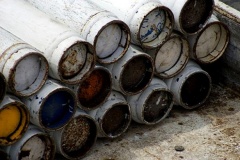Butene or Butane mixture
| Infobox on Butene or Butane mixture | |
|---|---|
| Example of Butene or Butane mixture |  |
| Facts | |
| Origin | - |
| Stowage factor (in m3/t) | - |
| Humidity / moisture | - |
| Ventilation | - |
| Risk factors | See text |
Butene or Butane mixture
Contents
Description
Butane is a gas with the formula C4H10 that is an alkane with four carbon atoms. The term may refer to either of two structural isomers, n-butane or isobutane (or "methylpropane"), or to a mixture of these isomers. In the IUPAC nomenclature, however, "butane" refers only to the n-butane isomer (which is the isomer with the unbranched structure). Butanes are highly flammable, colorless, easily liquefied gases. The name butane comes from the roots but- (from butyric acid) and -ane.
Application
The most common use of butane is as lighter fuel for a common lighter or butane torch.
Butane gas is sold bottled as a fuel for cooking and camping. When blended with propane and other hydrocarbons, it is referred to commercially as LPG, for liquified petroleum gas. It is also used as a petrol component, as a feedstock for the production of base petrochemicals in steam cracking, as fuel for cigarette lighters and as a propellant in aerosol sprays such as deodorants.
Very pure forms of butane, especially isobutane, can be used as refrigerants and have largely replaced the ozone layer-depleting halomethanes, for instance in household refrigerators and freezers. The system operating pressure for butane is lower than for the halomethanes, such as R-12, so R-12 systems such as in automotive air conditioning systems, when converted to butane will not function optimally.
Cordless hair irons are usually powered by butane cartridges.
Shipment / Storage
Butane is an extremely flammable, colorless gas with an added gas odor. Carriage in portable tanks is permitted.
A leakage can be recognized by :
- A penetrating, gasoline-like odor.
- A hissing sound
- Frost formation around the leak
- Fog clouds of cooled down or frozen atmospheric moisture
Note that the gas is heavier than air and can extend a fair distance from the source; particularly during calm spells (in ports) explosive mixtures with air may be formed at unexpected distances from the receptacles.
Empty uncleaned cylinders and portable tanks are subject to the same provisions as full ones. Only when receptacles are accompanied by a certificate stating that they are gas free, may they be treated as non-hazardous cargo. Usually receptacles are shipped back to the manufacturer to be filled with the same substance again. It is, therefore, unlikely that truly emptied receptacles will be offered for shipment.
The liquefied petroleum gases comprise propane, butane and mixtures of the two. Butane stored in cylinders and thus known as bottled gas, has widespread use as a fuel for heating and cooking in remote locations. However, it is also an important octane enhancer for motor gasoline and a key petrochemical feedstock. Propane, too, is utilized as a bottled gas, especially in cold climates (to which its vapour pressure is more suited).
LNG is a very cold natural gas that is in a liquid form rather than gas. Chemically, it's mostly methane, with small amounts of ethane, propane, and butane. LPG (liquefied petroleum gas), sometimes referred to as bottled gas, is a heavier gas that can be liquefied under pressure or by refrigeration. It is mostly propane and butane. Gasoline is heavier still and is a liquid at room temperature. Heating oil is even heavier and doesn't boil unless heated. And asphalt is so heavy that it's a solid. But in a way they are all pretty similar, because they all burn.
Risk factors
For overseas carriage aspects of Chemicals, the readers are recommended to acquire or have access to a good chemical dictionary, and a copy of the International Maritime Dangerous Goods (IMDG) Code, issued by the International Maritime Organisation. Also consult the applicable MSDS sheet.











